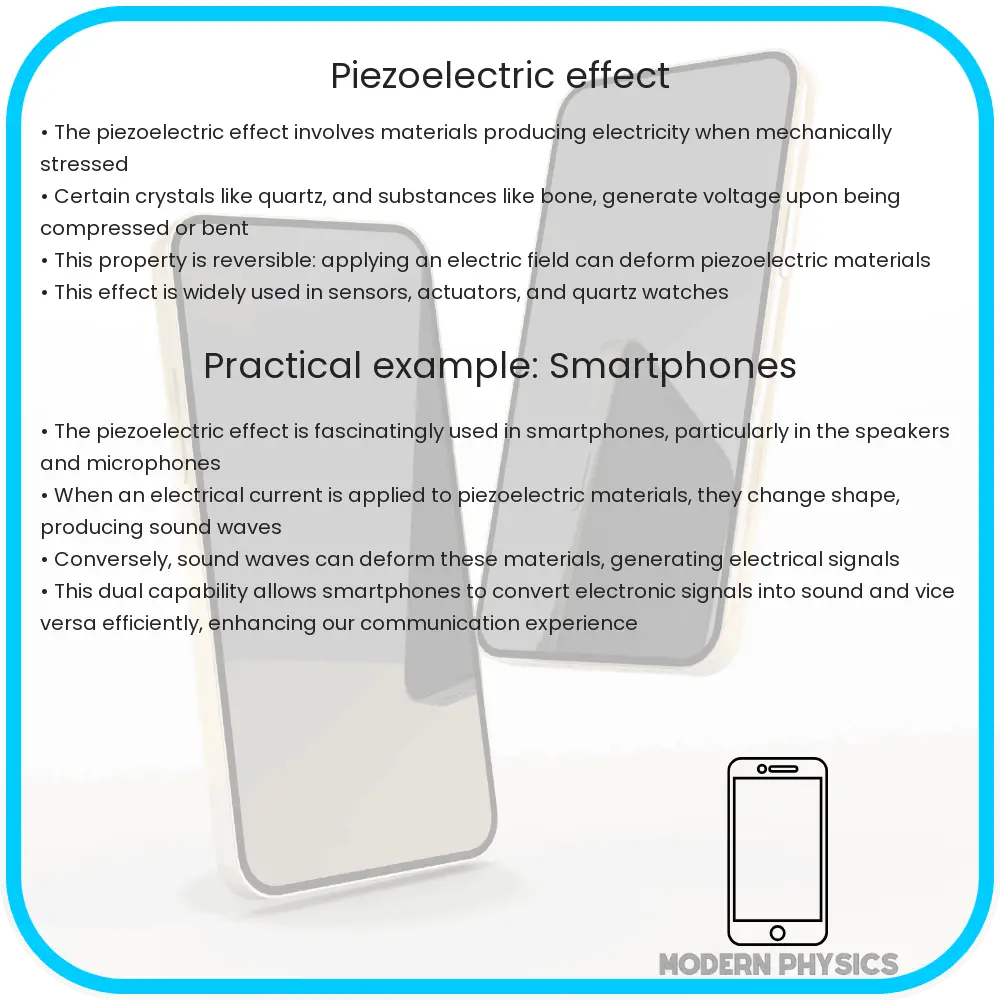Explore the piezoelectric effect: its principles, applications in tech and industry, advancements in material science, and future prospects.

Piezoelectric Effect: An Overview
The piezoelectric effect is a fascinating phenomenon where certain materials can generate an electric charge in response to applied mechanical stress. This unique property is found in various materials, including crystals, certain ceramics, and biological matter such as bone, DNA, and various proteins. Discovered in 1880 by the Curie brothers, the piezoelectric effect has since become a cornerstone in electrostatics and material science, leading to a wide range of applications.
Understanding the Principles
At its core, the piezoelectric effect is deeply rooted in the interplay between the mechanical and electrical states of a material. When a piezoelectric material is deformed, the distribution of electrical charges within the material changes, leading to an electrical potential. Conversely, when an electrical field is applied, these materials change shape, demonstrating the inverse piezoelectric effect.
This behavior can be explained by the material’s crystal lattice structure. In a piezoelectric crystal, the unit cells lack a center of symmetry, leading to a non-uniform distribution of positive and negative charges. When stress is applied, this asymmetry results in an external electric field. The mathematical representation of this phenomenon can be expressed as:
Q = d * F
where Q represents the generated charge, d is the piezoelectric constant, and F is the applied force.
Applications in Technology and Industry
The piezoelectric effect finds applications in a myriad of fields. One of the most common uses is in quartz watches, where a quartz crystal oscillates in response to an electric field, providing precise timekeeping. Additionally, piezoelectric materials are pivotal in medical ultrasound imaging. When subjected to an electric field, these materials vibrate and emit ultrasonic waves, which are then used to create images of internal body structures.
Other notable applications include:
- Ignition sources in lighters and gas stoves
- High-precision positioning systems
- Energy harvesting from mechanical vibrations
Advancements in material science have also led to the development of newer piezoelectric materials with enhanced properties, expanding the scope of potential applications.
Electrostatics Principles Behind Piezoelectricity
The electrostatic principles underlying piezoelectricity are inherently linked to the material’s polarization. Polarization, a key concept in electrostatics, refers to the orientation of electric dipoles within a material. In piezoelectrics, mechanical deformation affects this polarization, resulting in the generation of an electric field. This relationship is governed by the material’s dielectric constant and piezoelectric coefficients, which determine the efficiency and magnitude of the effect.
Understanding these principles is crucial for optimizing piezoelectric materials for specific applications, leading to innovations in both consumer electronics and industrial applications.
Advanced Developments and Future Prospects
Recent advances in piezoelectric technology have opened new horizons in various fields. Researchers are exploring the use of piezoelectric materials in energy harvesting, aiming to convert everyday mechanical stresses (such as walking or vehicle movement) into usable electrical energy. This approach has significant potential in sustainable energy solutions, particularly in powering small, low-energy devices like sensors and wearables.
In the realm of bioengineering, piezoelectric materials are being studied for their potential in medical implants and drug delivery systems. Their ability to respond to physiological movements and generate electrical impulses can be harnessed for more effective treatment methods.
Moreover, the field of nanotechnology has seen the rise of piezoelectric nanomaterials. These materials, at the nanoscale, demonstrate enhanced piezoelectric properties due to their increased surface area and quantum effects. This advancement is particularly promising in the development of ultra-sensitive sensors and novel electronic devices.
Challenges and Ethical Considerations
Despite the numerous applications and benefits, the development and use of piezoelectric materials come with challenges. The extraction and processing of certain piezoelectric materials, such as quartz, can have environmental impacts. Additionally, as the technology finds applications in surveillance and data collection, ethical considerations regarding privacy and consent become increasingly important.
Researchers and manufacturers are also working to overcome limitations such as material brittleness and the efficiency of energy conversion. Addressing these challenges is essential for the broader adoption and sustainable use of piezoelectric technologies.
Conclusion
The piezoelectric effect represents a remarkable intersection of physics, material science, and engineering. Its applications, ranging from everyday consumer products to cutting-edge medical and energy technologies, underscore its versatility and potential. As research continues to unveil new materials and refine existing ones, the scope of piezoelectric applications is likely to expand even further. Balancing technological advancement with ethical and environmental considerations will be key to harnessing the full potential of piezoelectric materials. The future of piezoelectric technology is not only promising but also a testament to the ongoing journey of scientific discovery and innovation.
